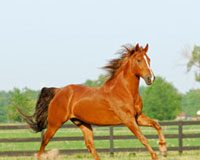To date this season (July 2006 to present), the University of Kentucky’s Livestock Disease Diagnostic Center (LDDC) has confirmed 40 cases of equine leptospirosis in the Central Kentucky region. Most of the observed cases have resulted in foal loss by pregnant mares.
Equine leptospirosis is a bacterial disease found worldwide that affects many species, including horses and people. The source of the bacteria is the urine of wild animals, including mice, squirrels, fox, skunks, opossums and deer. Other domestic species such as cattle, dogs and pigs can also be a source of infection. Horses are infected when bacteria enter through the skin or mucosal membranes of the eye or mouth by contact with blood, urine or tissues from infected animals. This infection can also occur when horses splash infected urine into their eyes or by eating hay or feed contaminated by infected urine.
Once infected, horses may experience fever, become listless or may go off their feed. Owners often see what appears to be painful eyes with swelling, squinting, blinking, cloudiness, tearing and swelling. Pregnant mares will often lose their foals late in gestation. Adult horses can die of liver and/or kidney failure and may show jaundice in the latter stages of the disease. If you see any of these symptoms in your horse, you should consult with your veterinarian.
The LDDC can assist your veterinarian in the diagnosis of leptospirosis by testing blood and urine for evidence of the disease. In addition, aborted or weak foals that die should be submitted to the laboratory for a complete necropsy and testing for the disease. Leptospirosis is a zoonotic disease—one that can be transmitted from animal to human. Although rare, it can occur and owners should be careful handling a suspect animal.
The drugs of choice for infected horses are oxytetracycline, streptomycin or penicillin. Vaccines are available for dogs and cattle, but unfortunately not for horses. The cattle vaccine has been used in horses with poor results and often with side effects.
Prevention of equine leptospirosis involves good management to keep wildlife out of areas where horses live and eat. Horses should not be allowed to drink from stagnant water or ponds that might be contaminated with cattle urine. Areas where known infected animals have been should be disinfected before introducing new animals.
A working group made up of LDDC and Gluck Equine Research Center scientists, along with a College of Public Health biostatistician and two local equine practitioners, has begun a comprehensive Bluegrass-based epidemiological study and a nationwide economic impact study of equine leptospirosis. The hope is that these efforts will raise awareness regarding this disease and will also help foster the development of a much needed leptospirosis vaccine for horses.






Great info, good to know, thank you!
Thanks for such good info. This really helped me with my decision on vacs.
I have a horse that was just diagnosed with lepto and wished this would give more information.